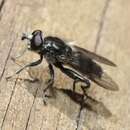ar
الأسماء في صفحات التنقل


Chalcosyrphus is a genus of hoverflies in the subfamily Eristalinae. Many species exhibit some degree of mimicry of various sawflies and other hymenopterans and are often brightly coloured or metallic in hue. The adults are similar in structure and behavior to the related genus Xylota but differ in larval morphology. They can be found throughout Europe, Asia, and North America and seem to prefer damper, boggy habitats. The larvae are saproxylic feeders in rotten wood in these habitats.[9][10]
Subgenus: Cheiroxylota
Subgenus: Dimorphoxylota
Subgenus: Hardimyia [18]
Subgenus: Neplas
Subgenus: Neploneura [18]
Subgenus: Spheginoides
Subgenus: Syrittoxylota
Subgenus: Xylotina
Subgenus: Xylotodes
Subgenus: Xylotomima
Unplaced
Chalcosyrphus is a genus of hoverflies in the subfamily Eristalinae. Many species exhibit some degree of mimicry of various sawflies and other hymenopterans and are often brightly coloured or metallic in hue. The adults are similar in structure and behavior to the related genus Xylota but differ in larval morphology. They can be found throughout Europe, Asia, and North America and seem to prefer damper, boggy habitats. The larvae are saproxylic feeders in rotten wood in these habitats.
Chalcosyrphus es un género de moscas sírfidas de la subfamilia Eristalinae. Muchas especies son mímicos de avispas y otros himenópteros y son de colores brillantes o metálicos. Los adultos son similares en estructura y comportamiento a los del género relacionado Xylota pero se diferencian en la morfología de las larvas. Se los encuentra en Europa, Asia, Norte América y Sur América.[9] Prefieren hábitats húmedos o pantanosos. Las larvas se alimentan de madera podrida.[10][11]
Subgénero: Chalcosyrphus
Subgénero: Cheiroxylota
Subgénero: Dimorphoxylota
Subgénero: Hardimyia [19]
Subgénero: Neplas
Subgénero: Neploneura [19]
Subgénero: Spheginoides
Subgénero: Syrittoxylota
Subgénero: Xylotina
Subgénero: Xylotodes
Subgénero: Xylotomima
Incerta sedis
|doi-access= ignorado (ayuda) |doi-access= ignorado (ayuda) Chalcosyrphus es un género de moscas sírfidas de la subfamilia Eristalinae. Muchas especies son mímicos de avispas y otros himenópteros y son de colores brillantes o metálicos. Los adultos son similares en estructura y comportamiento a los del género relacionado Xylota pero se diferencian en la morfología de las larvas. Se los encuentra en Europa, Asia, Norte América y Sur América. Prefieren hábitats húmedos o pantanosos. Las larvas se alimentan de madera podrida.
Chalcosyrphus est un genre de diptères de la famille des Syrphidae, de la sous-famille des Eristalinae et de la tribu des Xylotini.
Sous-genres:
Espèce non-classée:
Chalcosyrphus est un genre de diptères de la famille des Syrphidae, de la sous-famille des Eristalinae et de la tribu des Xylotini.
Råtevedblomsterfluer (slekten Chalcosyrphus) er en gruppe av fluer som tilhører familien blomsterfluer (Syrphidae). Slekten omfatter ca. 110 kjente arter, fire av dem forekommer i Norge, men alle utenom én er svært sjeldne. De er knyttet til skog.
Middelsstore (8-15 mm), slanke blomsterfluer, grunnfargen svart men ofte delvis røde eller gule. De ligner særlig på Xylota-artene, men skiller seg fra disse ved at de har lange hår på buken. Hodet er kort og bredt. Fasettøynene er nakne, og møtes i pannen hos hannene. Antennene sitter på et fremspring i pannen. Ansiktet er svart, litt uthulet under antennene, munnkanten litt fremskytende. Thorax er nesten kvadratisk med avrundede hjørner, mer eller mindre kledt med lys bestøvning, oftest med et par lyse lengdestriper i midten. Bakkroppen er avlang, mer eller mindre parallellsidig, sparsomt kledt med fine hår, gjerne med sølvfargede eller gule flekker, eller deler av bakkroppen kan være rød. Beina er ulikt fargede, baklårene kraftig fortykkede, bakleggene krumme. Vingene er klare eller med utydelige, brune flekker.
Fluene er knyttet til skog med et innslag av døde eller døende trær. Larvene utvikler seg trolig i råtten ved eller under bark, men biologien er lite kjent for de fleste av artene.
Slekten forekommer i Palearktis og i Nord-Amerika.
Råtevedblomsterfluer (slekten Chalcosyrphus) er en gruppe av fluer som tilhører familien blomsterfluer (Syrphidae). Slekten omfatter ca. 110 kjente arter, fire av dem forekommer i Norge, men alle utenom én er svært sjeldne. De er knyttet til skog.
Mulmblomflugor (Chalcosyrphus) är ett släkte i familjen blomflugor. Även släktena Brachypalpoides[förtydliga] och Brachypalpus har det svenska namnet mulmblomflugor.
Mulmblomflugor är medelstora till stora (7 till 15 millimeter) långsmala blomflugor med karakteristiskt uppsvullna baklår. Huvudet är betydligt bredare än långt. De är övervägande mörka med ibland röda eller gula inslag. Antennerna sitter på en utskjutande sockel. Typiskt för släktet är att bukplåten mellan de bakersta benparen (metasternum) har både långa och korta hår.[1]
Mulmblomflugor lever i skogar med gamla träd där larverna lever i savansamlingar eller röthål i stubbar och lågor, biologin är dock i många fall dåligt känd. De vuxna flugorna besöker olika sorters blommor.[1]
Det finns cirka 110 arter i släktet varav 43 i palearktis och 9 i Europa.[1]
Släktet Chalcosyrphus ingick tidigare i släktet Xylota.[1]
Följande fem arter förekommer i Norden och i Sverige.[1]
Svenskt namn Vetenskapligt namn Utbredning i Sverige Nordlig mulmblomfluga C. jacobsoni Endast 4 fynd i norra Sverige. Fläckig mulmblomfluga C. nemorum Större delen av Sverige. Tämligen vanlig i de östra landskapen. Svart mulmblomfluga C. nigripes Mycket sällsynt i norra Sverige. Tallmulmblomfluga C. piger Mycket sällsynt i Götaland och Svealand. Rödbent mulmblomfluga C. valgus Större delen av Sverige utom i fjällen och längst i söder. Ej talrik.Chalcosyrphus betyder kopparfärgad blomfluga.[1]
Mulmblomflugor (Chalcosyrphus) är ett släkte i familjen blomflugor. Även släktena Brachypalpoides[förtydliga] och Brachypalpus har det svenska namnet mulmblomflugor.
Chalcosyrphus là một chi ruồi trong họ Syrphidae.[1]